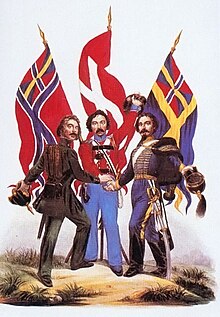| Revision as of 19:44, 13 April 2018 editApolloCarmb (talk | contribs)Extended confirmed users1,104 edits →History← Previous edit | Revision as of 19:46, 13 April 2018 edit undoApolloCarmb (talk | contribs)Extended confirmed users1,104 edits →Current situation: no sourceTag: section blankingNext edit → | ||
| Line 16: | Line 16: | ||
| Despite the movement severely dwindling there was a resurgence of Pan-Scandinavian sentiment in the latter part of the ].<ref name=brit/> | Despite the movement severely dwindling there was a resurgence of Pan-Scandinavian sentiment in the latter part of the ].<ref name=brit/> | ||
| ==Current situation== | |||
| After ] a decade of Nordic integration created initiatives and intergovernmental bodies such as the ], the ] and ]. Nordic cooperation was however undermined during the ] because Sweden and Finland were not members of ]. ] and the accession of Sweden, Finland and Denmark to the EU, without Norway and Iceland, has undermined Nordic integration. | |||
| ==See also== | ==See also== | ||
Revision as of 19:46, 13 April 2018


Scandinavism, also called Scandinavianism, Pan-Scandinavianism, is an ideology that support various degrees of cooperation among the Scandinavian Countries. Scandinavism and Nordism are interchangeable terms for the literary, linguistic and cultural movement that focuses on promoting a shared Nordic past, a shared cultural heritage, a common Scandinavian mythology and a common linguistic root in Old Norse, and which led to the formation of joint periodicals and societies in support of Scandinavian literature and languages. However, political Scandinavism and political Nordism are two distinct political movements which emerged at different times.
History
Pan-Scandinavianism originated in the 19th-century. The Pan-Scandinavian movement paralleled the unification movements of Germany and Italy. As opposed to the German and Italian counterparts, the Scandinavian state-building project was not successful and is no longer pursued. It was at its height in the mid-19th century and supported the idea of Scandinavian unity. It was spurred on by philological and archaelogical discoveries of the 18th century and 19th centuries, the rise of Pan-Germanism (and Pan-Slavism) and a general fear of Russian expansionism.
The movement was initiated by Danish and Swedish university students in the 1840s, with a base in Scania. In the beginning, the political establishments in the two countries, including the absolute monarch Christian VIII and Charles XIV with his "one man government", were suspicious of the movement. The movement was a significant force from 1846 to 1864, however the movement eventually dwindled and only had strong support among the Swedish-speaking population of Finland.
The collapse of Pan-Scandinavianism came in 1964 when the Second Schleswig-Holstein War broke out. King Charles XV who was the King of Sweden-Norway from 1859 until his death in 1872 who in spite of championing Pan-Scandinivianism failed to help Denmark in the war.
Author Hans Christian Andersen became an adherent of Scandinavism after a visit to Sweden in 1837, and committed himself to writing a poem that would convey the relatedness of Swedes, Danes, and Norwegians. It was in July 1839, during a visit to the island of Funen in Denmark, that Andersen first wrote the text of his poem, Jeg er en Skandinav ("I am a Scandinavian"). Andersen composed the poem to capture "the beauty of the Nordic spirit, the way the three sister nations have gradually grown together", as part of a Scandinavian national anthem. Composer Otto Lindblad set the poem to music, and the composition was published in January 1840. Its popularity peaked in 1845, after which it was seldom sung. Andersen spent two weeks at the Augustenborg Palace in the autumn of 1844.
Despite the movement severely dwindling there was a resurgence of Pan-Scandinavian sentiment in the latter part of the 20th century.
See also
Further Reading
- 'Denmark, Norway, and Sweden: Pan-Scandinavianism and Nationalism' by Mary Hilson
- 'Pan-Scandinavianism. Reference Points in the 19th Century (1815-1864) by Mircea-Cristian Ghenghea
References
- ^ "Pan-Scandanavianism". Encyclopedia Britannica.
- ^ "Pan-Scandinavianism". (2007). In Encyclopædia Britannica. Retrieved April 29, 2007, from Encyclopædia Britannica Online.
- The Literary Scandinavism Archived 2007-06-23 at the Wayback Machine. Øresundstid, 2003. Retrieved 6 May 2007.
- ^ Ola Tunander (1999). "Nordic cooperation", UDA085ENG. In Nytt fra Norge, ODIN – Information from the government and the ministries, Ministry of Foreign Affairs, Norway. See also Tunander, Ola (1999). "Norway, Sweden and Nordic cooperation". In The European North – Hard, soft and civic security. Eds. Lassi Heininen and Gunnar Lassinantti. The Olof Palme International Center/Arctic Centre, University of Lapland, 1999. pp. 39–48. ISBN 951-634-690-1.
- https://books.google.ie/books?id=jRQ9AAAAIAAJ&pg=PA220&dq=pan+scandinavianism&hl=en&sa=X&ved=0ahUKEwjCqIi9_bfaAhULXMAKHXykBHsQ6AEIOjAD#v=onepage&q=scandinavianism&f=false
- ^ The Students Archived 2007-08-13 at the Wayback Machine. Øresundstid, 2003. Retrieved 6 May 2007.
- "Charles XV". Encyclopedia Britannica.
- "About Pan-Scandinavianism. Reference Points in the 19th Century (1815-1864)". academia.edu.
- ^ "I am a Scandinavian". Hans Christian Andersen and Music. Retrieved 2007-01-12.
- Bredsdorff 1975, p. 169 harvnb error: no target: CITEREFBredsdorff1975 (help)
- https://port.rl.talis.com/items/D8F0205C-25AE-65A6-16EB-850B430B8C38.html
External links
- The Helsinki Treaty of 1962 Nicknamed as constitution of the Nordic Countries.